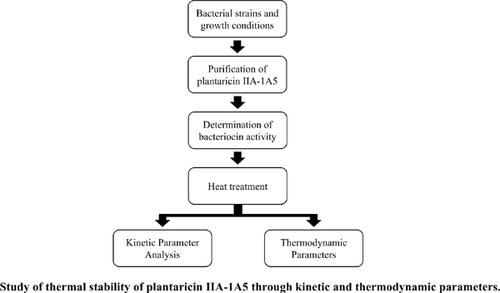Protein & Peptide Letters ( IF 1.6 ) Pub Date : 2021-05-31 , DOI: 10.2174/0929866527999201123213841 Muhamad Arifin 1 , Cahyo Budiman 1 , Kazuhito Fujiyama 2 , Irma Isnafia Arief 1

|
Background: Plantaricin IIA-1A5 is a bacteriocin produced by Lactobacillus plantarum IIA-1A5, a locally isolated probiotic from Indonesia. Plantaricin IIA-1A5 exhibits antibacterial activity against wide spectrum of pathogenic bacteria, thus promising to be applied in various food products. Nevertheless, thermal stability of this bacteriocin remains to be fully investigated.
Objective: This study aims to determine thermal stability of plantaricin IIA-1A5 through kinetic and thermodynamic parameters.
Method: To address, plantaricin IIA-1A5 was purified from Lactobacillus plantarum IIA-1A5, which was growth under whey media, using ammonium sulfate precipitation followed by ionexchange chromatography. Purified plantaricin IIA-IA5 was then subjected to analysis of its bacteriocin activity. The thermal inactivation of bacteriocin from L. plantarum IIA-1A5 was calculated by incubating the bacteriocin at different temperatures ranging from 60-80 °C for 30 to 90 min, which was then used to calculate its kinetic and thermodynamic parameters.
Results: The result showed the inactivation rates (k-value) were ranging from 0.008 to 0.013 min-1. Heat resistance of plantaricin IIA-1A5 (D-value) at constant heating temperature of 60, 65, 70, 75, and 80 °C were 311.6, 305.9, 294.5, 198.9, and 180.2 min, which indicated a faster inactivation at higher temperatures. D-value sensitivity for temperature changes (z-value) was calculated to be 75.76 °C. Further, thermodynamic analysis suggested that plantaricin IIA-1A5 is thermostable, with activation energy (Ea) of 29.02 kJ mol-1.
Conclusion: This result showed that plantaricin IIA-1A5 is considerably more heat-stable than plantaricin members and promises to be applied in food industries where heat treatments are applied. Furthermore, a possible mechanism by which plantaricin IIA-1A5 maintains its stability was also discussed by referring to its thermodynamic parameters.
中文翻译:

Plantaricin IIA-1A5 的动力学和热力学研究,一种由印度尼西亚益生菌植物乳杆菌IIA-1A5产生的细菌素
背景:Plantaricin IIA-1A5 是一种由植物乳杆菌 IIA-1A5 产生的细菌素,它是一种从印度尼西亚本地分离的益生菌。Plantaricin IIA-1A5 对广谱病原菌具有抗菌活性,因此有望应用于各种食品中。然而,这种细菌素的热稳定性仍有待充分研究。
目的:本研究旨在通过动力学和热力学参数确定车前草素 IIA-1A5 的热稳定性。
方法:为了解决这个问题,使用硫酸铵沉淀和离子交换色谱法从植物乳杆菌 IIA-1A5 中纯化植物素 IIA-1A5,植物乳杆菌 IIA-1A5 在乳清培养基下生长。然后对纯化的车前草素 IIA-IA5 进行细菌素活性分析。植物乳杆菌 IIA-1A5 中细菌素的热灭活计算方法是将细菌素在 60-80°C 的不同温度下孵育 30 到 90 分钟,然后用于计算其动力学和热力学参数。
结果:结果显示失活率(k 值)范围为 0.008 至 0.013 min-1。车前草素 IIA-1A5(D 值)在 60、65、70、75 和 80 °C 的恒定加热温度下的耐热性为 311.6、305.9、294.5、198.9 和 180.2 分钟,这表明在较高温度下失活更快. 温度变化的 D 值灵敏度(z 值)计算为 75.76 °C。此外,热力学分析表明植物素 IIA-1A5 是热稳定的,活化能 (Ea) 为 29.02 kJ mol-1。
结论:该结果表明,车前草素 IIA-1A5 的热稳定性明显高于车前草素成员,并有望应用于应用热处理的食品行业。此外,还通过参考其热力学参数讨论了车前草素 IIA-1A5 保持其稳定性的可能机制。



























 京公网安备 11010802027423号
京公网安备 11010802027423号